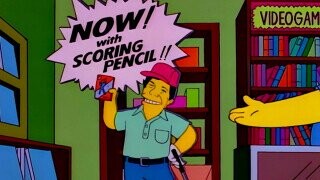5 Pop-Culture Myths That You Believe Because of ‘The Simpsons’

As those of us who grew up watching The Simpsons know, the beloved cartoon series is full of edifying insights beneficial to younger viewers. It has helped us learn about everything from space exploration, to the miraculous nature of zinc, to the importance of not handing over all your money to smooth-talking monorail salesmen.
Click right here to get the best of Cracked sent to your inbox.
Don't Miss
The Simpsons has also taught kids a lot about the world of pop culture — it’s how some of us first heard about Twin Peaks, 2001: a Space Odyssey and the comedic stylings/violent rage of Gallagher.
But some of these references may have been a tad misleading. Yes, it seems that some of The Simpsons’ pop-culture teachings weren’t quite as cromulent as they initially appeared, such as how…
There Is No Pro Golfer Named Lee Carvallo
The episode “Marge Be Not Proud” finds Bart shoplifting the ultra-violent video game Bonestorm from the local Try-N-Save. After Bart reconciles with Marge, she gives him an early Christmas present, the hot new game “every boy wants,” which turns out to be the overstocked dud Lee Carvallo’s Putting Challenge.
The hilariously boring game has subsequently become a prominent piece of Simpsons’ mythology; fans have even created actual playable versions of this fake terrible product.
A lot of us watching the show at the time assumed that “Lee Carvallo” was the name of an actual professional golfer. But that’s not the case. Lee Carvallo was an invention of the series. To be fair, who can name a single pro golfer other than Tiger Woods and Happy Gilmore? Also, the game was seemingly a parody of a Nintendo game featuring a similarly-named, yet real, athlete: Lee Trevino’s Fighting Golf, which, despite the inclusion of the word “fighting,” is also completely tedious.
‘Paint Your Wagon’ Is 100 Percent a Real Movie
The musical clip show “All Singing, All Dancing” features a framing story in which Homer and Bart rent a Clint Eastwood, Lee Marvin “shoot ’em up Western” called Paint Your Wagon (presumably with blood). But when they start watching the movie, it is, in fact, a goofy musical with little-to-no killing.
Simpsons fans who weren’t around in 1969 were surprised to find out that this ridiculous movie wasn’t a parody created for the show; it was an actual honest-to-goodness Hollywood musical starring Eastwood — although, from what we can tell, it doesn’t contain any uptempo numbers about literally painting a wooden wagon.
Paint Your Wagon was a production nightmare; it went “notoriously over budget” and was considered a “box office failure,” reportedly inspiring Eastwood to create his own production company so that he wouldn’t be forced to appear in any more expensive musical turds.
There Is No ‘Rocky VII: Adrian’s Revenge’
When Bart is forced to decode a room full of doors marked only with Roman numerals (lest he be devoured by one of several man-eating tigers from the Shelbyville Zoo), he’s able to figure out which door leads to safety after concluding that Rocky V plus Rocky II equals Rocky VII: Adrian’s Revenge.
Since a lot of kids watched The Simpsons before they ever got around to the oeuvre of Sylvester Stallone, understandably, some folks believed that Adrian’s Revenge was a genuine motion picture, not realizing that, back when the episode aired, the Rocky franchise consisted of just five films. Of course, Stallone eventually made a sixth Rocky movie in 2006, simply titled Rocky Balboa.
But as Rocky Balboa revealed, Rocky’s wife Adrian passed away between films — and thankfully, the seventh movie in the series, Creed, didn’t fulfill The Simpsons’ prophecy by introducing zombies into the Rocky-verse.
No, ‘A Streetcar Named Desire’ Was Never a Musical
Marge’s first foray into community theater sees her playing the lead role of Blanche Dubois in an adaptation of A Streetcar Named Desire called Oh Streetcar! This modern take on the theatrical classic features singing, dancing and haphazardly fired laser beams symbolizing Blanche’s “descent into madness.”
‘90s kids who didn’t know a goddamn thing about the works of Tennessee Williams — likely because he wasn’t one of the original Power Rangers — assumed that A Streetcar Named Desire was really a musical, not realizing that the song-and-dance treatment of the famously tragic story was the entire point of the joke.
‘Little Women’ Doesn’t End the Way Moe Reads It
After Homer befriends Flanders and brings him down to Moe’s for a beer, Springfield’s resident do-gooder immediately recognizes Springfield’s resident intoxicant peddler as the guy who routinely makes trips to the hospital and “reads to sick children.”
Later in the episode, it becomes clear why Moe’s is always mysteriously closed on Wednesdays when we see Moe reading to a group of unhoused folks at Helter Shelter, tearfully concluding Louisa May Alcott’s classic Little Women with the book’s iconic final line: “And then they realized they were no longer little girls, they were little women.”
The only problem is, that’s not how Little Women ends. The book actually wraps up with the March family matriarch exclaiming: “O my girls, however long you may live, I can never wish you a greater happiness than this!”

But a generation of philistines who prefer prime-time cartoons to literary masterpieces mistakenly bought into the Moe Szyslak version.
You (yes, you) should follow JM on Twitter (if it still exists by the time you’re reading this).